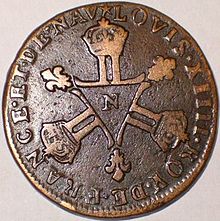Coin
A coin is a piece of metal that is used as currency, or money. The earliest coins were in Lydia, in what is Turkey today, in 7th Century BC. They were made from electrum, an alloy found in riverbeds.[1]

Most people use coins as currency. They usually have lower value than banknotes. Most are made in government mints.
Appearance
changeMany coins have unique or complicated decorations; one side often has the picture of a king or ither important person's head on it.
The different decorations on each side of a coin might be used to decide things randomly. This is called "tossing a coin". A person can throw the coin into the air and catch it. You then look at which side is facing up. If the head is facing up it is called "heads", if the other side is facing up it is called "tails". Before tossing the coin someone has to decide what each side means. Tossing a coin can be a type of gambling, which is illegal (against the law) in some countries.
Collecting
changeBecause coins have been made for a very long time, some people collect old coins. They can be much cheaper than other old things, especially if they are made of cheap metals like copper. Older coins normally cost more than newer ones, but rarity matters more-some coins from the 1920s cost vast sums, while some Roman coins cost very little.